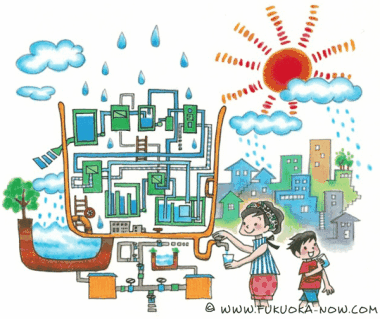Hakata Culture vol.89
Fukuoka's Water-Conscious Citizenry

Water: we need it to live, but per capita household water use in Japan almost doubled between the 1960s and the 2000s. The biggest increase has been recorded in the populous urban centers, with each resident using an average of 330 L of water per day (FY2012). The citizens of Fukuoka, however, use 270 L per day, or 60 L less than the daily average for major cities. But why are Fukuokans so water-conscious?
Geographically, water has always been scarce in Fukuoka. The only rivers in and around the city, which has added more population in step with its growth, are small ones. In 1978, Fukuoka suffered a severe drought, and after a long period without rain, water restrictions were enacted that ended up lasting 287 days. People formed long lines at water trucks, and some residents even moved away due to the drought.
Learning from this experience, Fukuoka City has since promoted water-conscious urban development. The City built storage dams to create new reservoirs, enacted measures to prevent leaks at existing dams, launched an efficient 24-hour water distributions system and began recycling wastewater and rainwater. Finally, in 2005, the Mizutopia desalination plant went into operation. Thanks to the water-consciousness of the citizens, the use of water-saving equipment has spread to many households, and a large number people strive to conserve water on a daily basis.
When another drought struck the city in 1994, there were no major disruptions and no water trucks were dispatched, despite a long period of water restrictions. Fukuoka has received high marks for its waterworks technology and water-saving urban development initiatives and is currently working to transfer its water-efficient technologies to the developing countries of Asia. In Japan, we take clean water for granted, but the next time you turn on the tap in Fukuoka, you might want to take a moment to be thankful for the efforts that have been made.
節水意識の高い福岡市民
毎日の生活に水は欠かせません。家庭で使用される1日の1人あたり水使用量は、1960年代から2000年代にかけて約2倍になっています。とりわけ人が集まる大都市では使用量が多く、大都市平均では約330リットル(2012年度)を使っているそうです。これに対し、福岡市では1日の市民1人あたりの水使用量は約270リットルで、大都市平均よりも少なめ。この理由は高い節水意識にあります。
1978年、福岡市を大渇水が襲いました。もともと福岡市は水源となる大きな河川を持たない上に、街がどんどん発展して人口が増加していました。そこへ雨が降らない状況が続き、ついに287日におよぶ給水制限を行うことになったのです。当時は給水車に人々の長い列ができ、渇水のために一時的に転居する市民もいたほどです。
この経験を教訓に、福岡市では節水型の都市づくりがすすめられました。周辺の貯水ダムなどの水源確保に加えて、漏水防止のための対策、効率的な24時間の配水システム、排水や雨水の再利用、さらに2005年から海水から淡水をつくる施設「まみずピア」も稼働しています。市民の節水意識も高く、家庭には節水型機器が普及し、こまめに蛇口を閉めるなどの節水方法を実行している人も多くいます。
おかげで1994年に同じく渇水を経験したときは、長期間の給水制限はあったものの、大きな混乱もなく、給水車が出動することもありませんでした。水資源に恵まれない福岡市の水道技術や節水型都市への取り組みは高く評価され、現在ではアジアの開発途上国などに水の有効利用に関する技術を伝えています。日本では当たり前のように蛇口から出る水のこと、改めて考えてみてはいかがでしょう。

